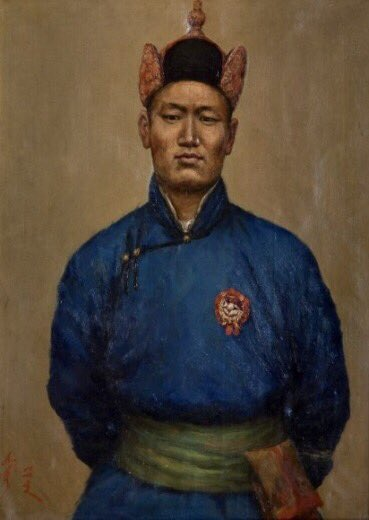More languages
More actions
(Created) Tag: Visual edit |
(Death) Tag: Visual edit |
||
| (4 intermediate revisions by the same user not shown) | |||
| Line 1: | Line 1: | ||
{{Infobox revolutionary|name=Damdin Sükhbaatar|native_name=Дамдины Сүхбаатар<br>ᠳᠠᠮᠳᠢᠨ ᠤ ᠰᠦᠬᠡᠪᠠᠭᠠᠲᠤᠷ|image_size=200|birth_date=1893 February 2|birth_place=Khüree, [[Qing dynasty]]|death_date=1923 February | {{Infobox revolutionary|name=Damdin Sükhbaatar|native_name=Дамдины Сүхбаатар<br>ᠳᠠᠮᠳᠢᠨ ᠤ ᠰᠦᠬᠡᠪᠠᠭᠠᠲᠤᠷ|image_size=200|birth_date=1893 February 2|birth_place=Khüree, [[Qing dynasty]]|death_date=1923 February 22|death_place=[[Bogd Khanate]]|nationality=Mongolian|political_orientation=[[Marxism–Leninism]]|political_party=[[Mongolian People's Revolutionary Party]]|image=Damdin Sükhbaatar.png}} | ||
'''Damdin Sükhbaatar''' (1893 February 2 – 1923 February 20) was the leader of the [[Mongolian People's Revolution]] of 1921. | '''Damdin Sükhbaatar''' (1893 February 2 – 1923 February 20) was the leader of the [[Mongolian People's Revolution]] of 1921. | ||
== Early life == | == Early life == | ||
Sükhbaatar was born in a poor [[Peasantry|peasant]] (''arat'') family in 1893. His family moved to Örgöö (now Ulaanbaatar) when he was about five. At age 14, he began transporting goods between Örgöö and Hiagt by horse.<ref name=":03">{{Citation|author=A. A. Guber, et al.|year=1973|title=History of the Mongolian People's Republic|title-url=https://archive.org/details/HistoryOfTheMPR/page/n116/mode/1up|chapter=The Mongolian People's Revolution and the Proclamation of the Mongolian People's Republic|page=}}</ref><sup>:277</sup> | |||
In 1912, Sükhbaatar was drafted into the Mongolian army and became a squadron commander. He learned about the [[Russian revolution of 1917|October Revolution]] from a pro-[[Bolsheviks|Bolshevik]] instructor from [[Russian Soviet Federative Socialist Republic (1917–1991)|Russia]].<ref name=":03" /><sup>:277–8</sup> | |||
== Revolutionary movement == | |||
After leaving the army in 1918, Sükhbaatar returned to Örgöö to work in a printing shop with the Russian citizens Gembarzhevsky and Kucherenko. He first met [[Khorloogiin Choibalsan]] in the fall of 1919. In 1920, he tried to connect with the Bolsheviks but failed because of the [[Russian Civil War|Civil War]]. He joined the newly formed Mongolian People's Revolutionary Party on 1920 June 25.<ref name=":03" /><sup>:278–9</sup> | |||
When Choibalsan and other party leaders left for Russia to negotiate for assistance, Sükhbaatar stayed in Mongolia to organize until July 15, when he also went to Russia. He met up with Choibalsan's group on July 22 in Verkhneudinsk (now Ulaan-Üde), the capital of the [[Far Eastern Republic]], and stayed in Irkutsk with Choibalsan while other party members visited [[Moscow]] or returned to Örgöö. When the Zhili clique found out that Sükhbaatar had requested support from the Bolsheviks, they offered a $10,000 reward for his capture.<ref name=":03" /><sup>:280–3</sup> | |||
After [[Soliin Danzan]] and the others returned from Moscow to Irkutsk in 1920 November, Sükhbaatar said they should hold a party congress as soon as possible. He and Choibalsan returned to Mongolia on November 22, and Sükhbaatar organized 50 border troops in northern Mongolia. The First Party Congress on 1921 March 1 appointed him as commander-in-chief of the newly formed [[Mongolian People's Army|People's Army]].<ref name=":03" /><sup>:285–90</sup> | |||
== Post-revolution == | |||
On 1921 July 16, Mongolia formed its first permanent people's government with [[Damdin Sükhbaatar]] as Commander-in-Chief and Minister of War.<ref name=":03" /><sup>:300</sup> | |||
== Death == | |||
Sükhbaatar died on 1923 February 22, and his funeral was held on February 26.<ref name=":03" /><sup>:314</sup> | |||
== References == | == References == | ||
[[Category:Revolutionaries]] | [[Category:Revolutionaries]] | ||
{{DEFAULTSORT:Sükhbaatar}} | {{DEFAULTSORT:Sükhbaatar}} | ||
Latest revision as of 20:32, 6 June 2024
Damdin Sükhbaatar Дамдины Сүхбаатар ᠳᠠᠮᠳᠢᠨ ᠤ ᠰᠦᠬᠡᠪᠠᠭᠠᠲᠤᠷ | |
|---|---|
 | |
| Born | 1893 February 2 Khüree, Qing dynasty |
| Died | 1923 February 22 Bogd Khanate |
| Nationality | Mongolian |
| Political orientation | Marxism–Leninism |
| Political party | Mongolian People's Revolutionary Party |
Damdin Sükhbaatar (1893 February 2 – 1923 February 20) was the leader of the Mongolian People's Revolution of 1921.
Early life[edit | edit source]
Sükhbaatar was born in a poor peasant (arat) family in 1893. His family moved to Örgöö (now Ulaanbaatar) when he was about five. At age 14, he began transporting goods between Örgöö and Hiagt by horse.[1]:277
In 1912, Sükhbaatar was drafted into the Mongolian army and became a squadron commander. He learned about the October Revolution from a pro-Bolshevik instructor from Russia.[1]:277–8
Revolutionary movement[edit | edit source]
After leaving the army in 1918, Sükhbaatar returned to Örgöö to work in a printing shop with the Russian citizens Gembarzhevsky and Kucherenko. He first met Khorloogiin Choibalsan in the fall of 1919. In 1920, he tried to connect with the Bolsheviks but failed because of the Civil War. He joined the newly formed Mongolian People's Revolutionary Party on 1920 June 25.[1]:278–9
When Choibalsan and other party leaders left for Russia to negotiate for assistance, Sükhbaatar stayed in Mongolia to organize until July 15, when he also went to Russia. He met up with Choibalsan's group on July 22 in Verkhneudinsk (now Ulaan-Üde), the capital of the Far Eastern Republic, and stayed in Irkutsk with Choibalsan while other party members visited Moscow or returned to Örgöö. When the Zhili clique found out that Sükhbaatar had requested support from the Bolsheviks, they offered a $10,000 reward for his capture.[1]:280–3
After Soliin Danzan and the others returned from Moscow to Irkutsk in 1920 November, Sükhbaatar said they should hold a party congress as soon as possible. He and Choibalsan returned to Mongolia on November 22, and Sükhbaatar organized 50 border troops in northern Mongolia. The First Party Congress on 1921 March 1 appointed him as commander-in-chief of the newly formed People's Army.[1]:285–90
Post-revolution[edit | edit source]
On 1921 July 16, Mongolia formed its first permanent people's government with Damdin Sükhbaatar as Commander-in-Chief and Minister of War.[1]:300
Death[edit | edit source]
Sükhbaatar died on 1923 February 22, and his funeral was held on February 26.[1]:314
